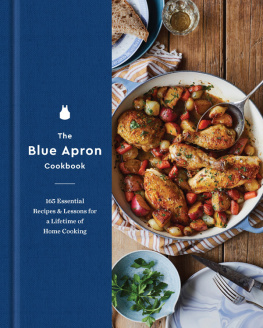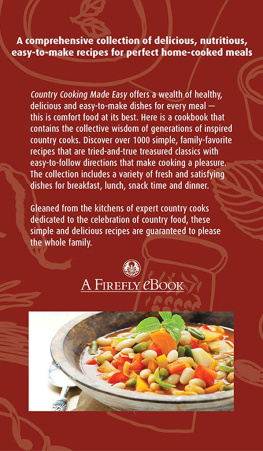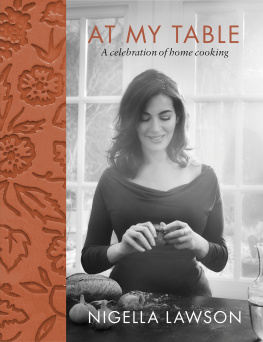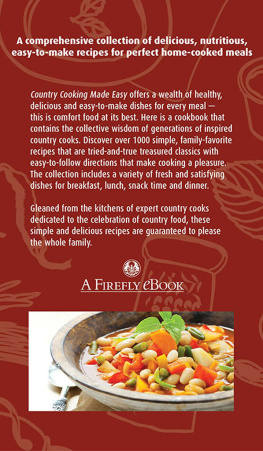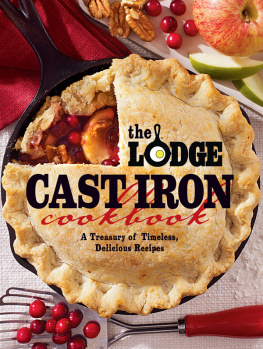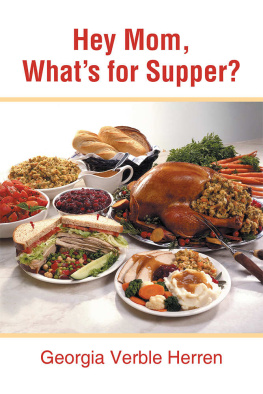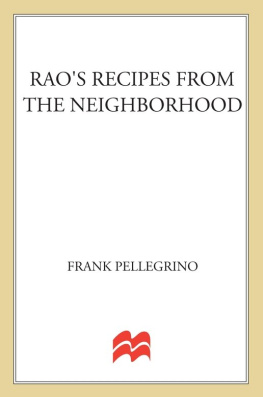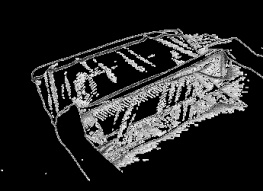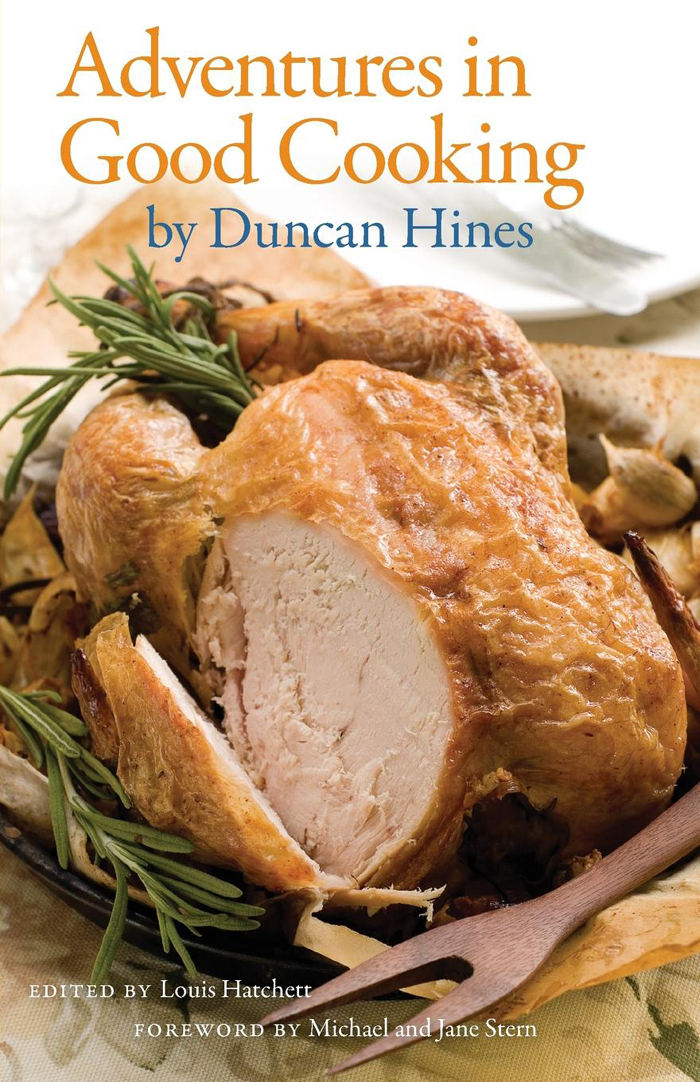Adventures in Good Cooking
Adventures in
Good Cooking
Duncan Hines
Edited by Louis Hatchett
Foreword by Michael and Jane Stern

Copyright 2014 by Louis Hatchett
The University Press of Kentucky
Scholarly publisher for the Commonwealth, serving Bellarmine University, Berea College, Centre College of Kentucky, Eastern Kentucky University, The Filson Historical Society, Georgetown College, Kentucky Historical Society, Kentucky State University, Morehead State University, Murray State University, Northern Kentucky University, Transylvania University, University of Kentucky, University of Louisville, and Western Kentucky University.
All rights reserved.
Editorial and Sales Offices: The University Press of Kentucky
663 South Limestone Street, Lexington, Kentucky 40508-4008
www.kentuckypress.com
Previously published in 2002 by Mercer University Press
The Library of Congress has cataloged the 2002 edition of this book as follows:
Adventures in good eating and the art of carving in the home
Duncan Hines / edited by Louis B. Hatchett, Jr.
1st ed.
p. cm.
Originally published: 1933
With a new introduction
ISBN 0-86554-809-0 (hardcover: alk paper)
1. Cookery, American I. Hatchett, Louis. II. Title
TX715 .H7226 2002
641.5973-dc21
2002151133
ISBN 978-0-8131-4468-9 (pbk.: alk. paper)
ISBN 978-0-8131-4470-2 (pdf)
ISBN 978-0-8131-4469-6 (epub)
This book is printed on acid-free paper meeting the requirements of the American National Standard for Permanence in Paper for Printed Library Materials.

Manufactured in the United States of America.

Member of the Association of American University Presses
For Linda Priscilla
Contents
Foreword
As a restaurant reviewer, Duncan Hines earned fame for his integrity, for his high standards of cleanliness as well as cuisine, and for his unfailing ability to find wonderful things to eat. It was a natural next step that the author of Adventures in Good Eating should carry those standards into a cookbook: Adventures in Good Cooking. As he conceived it, this was not to be merely an all-purpose collection of workable recipes. It was to be a pantheon of extraordinary recipes from the finest kitchens in America. To get the recipes, Hines went to restaurants that had earned inclusion in his guidebook. Most of the chefs and owners he approached were so grateful for his recognition (which had invariably boosted their business) that they were only too happy to share the secrets for some of their best and best-known dishes.
In these pages you will find outstanding recipes indeednone of them twenty-first-century trendy, but many of them timeless (Lindys Cheesecake from New York), and others of them time-burnished relics that deserve enthusiastic revival (Ham Pie with Cheese Biscuit Top from the Anderson Hotel of Wabasha, Minnesota; Baked Indian Pudding from the Toll House of Whitman, Massachusetts). Browsing through the bonanza of more than seven hundred dishes, from the Waldorf Astorias Brandied Grapefruit to Brennans Bananas Foster, is like sitting down in a restaurant that presents you with an extensive, inviting menu. There is so much one craves to taste.
What amazes us is that every recipe we have tried from this book really works, exactly as written. Having authored several cookbooks using favorite restaurants recipes, we have inevitably found ourselves rewriting and revising nearly everything the restaurants provided. As a rule, talented professional cooks are too good at what they do to pay close attention to precise measurements and exact times. They do it by feel and by taste. But Duncan Hines being Duncan Hines, you can be sure that each of the recipes he included passed muster in his own kitchen, presided over by his wife, or in the kitchen of a close and trusted relative. In addition to the recipes, the book is richly larded with savvy and fun marginalia (Apple pie without rat cheese is minus the umpth.), and it includes extensive directions on The Art of Carving in the Home.
As Roadfood explorers who consider ourselves deeply in debt to the pioneering work of Duncan Hines, we find the contents of this book especially alluring, because they so vividly reflect the interesting, regional, or unique meals Hines discovered in his travels and that he highlighted in his guidebook. Cooking from these pages is as close as you can come to actually exploring the culinary landscape along with the master. Here you will enjoy the sorts of extraordinary dishes that made eating on the road such a passion for Duncan Hines and a trip of delicious discovery for his millions of readers.
Michael and Jane Stern
Preface
As I was researching my biography of Duncan Hines (Duncan Hines: The Man Behind the Cake Mix), one of the items I had to examine was the last of a trio of books that Hines published in the latter half of the 1930s. In 1936 he self-published the first edition of his highly regarded Adventures in Good Eating, a guide to Americas finest roadside restaurants. He followed that up in 1938 with Lodging for a Night, his guide to the nations superior hotels and motels. And in 1939 he presented the non-traveling public with Adventures in Good Cooking, a collection of recipes that not only consisted of secret dishes from Americas best restaurants of the time but also featured a number of delectable edibles from his family and friends.
I tried to acquire a copy of this book (this was before the Internet arrived on the scene), but finding one was difficult. When I interviewed people who owned a copy and requested to borrow it for further examination, they were reluctant to part with it. It was as if they were lending someone their soul. They were very possessive of it. The copies I had a chance to peruse were markedly worn and had been used extensively. They most definitely had not sat on a bookshelf collecting dust. The people I interviewed, all in their seventies and eighties, swore by the books recipes. They swooned over its wonders, proclaiming it provided some of the most heavenly mouthfuls that had ever graced the human tongue.
Well, that got my attention. Instead of borrowing one of the cookbooks, I paid seventy-five dollars for a very good used copy. Once I examined it, I realized what all the fuss was about. These were extraordinarily good recipes. I concluded that todays public should have the opportunity to prepare, sample, and enjoy the same recipes that millions of others had savored a few generations earlier.
Most people have forgotten or have never been told that in the 1940s and 1950s, among American housewives, Duncan Hines was the most trusted name in the food industry. The name was synonymous with uncompromising quality, particularly in the realm of food.
From 1905 until 1938 Duncan Hines had been a salesman of printing wares and advertising specialties whose hobby was eating in roadside restaurants. But he wouldnt eat just anywhere. In that day and age, restaurants were not safe places in which to dine. Hundreds of Americans died as a result of unsanitary restaurant conditions; many others suffered severe stomach disorders after consuming squalid roadside fare. Eating in roadside restaurants in that day was a hit-or-miss affair. Sometimes you got lucky and had a wonderful meal; other times you did not. And if you were really unlucky, you went to the morgue. Especially in non-metropolitan areas, eating a meal away from home was always a risk and seldom a pleasure. As Duncan Hines crisscrossed the country as a salesman, whenever he dined in a restaurant that not only served excellent food but had a very clean kitchen in which to prepare it, he jotted down its name and location in a notebook and would visit it again next time he happened to be in town.


